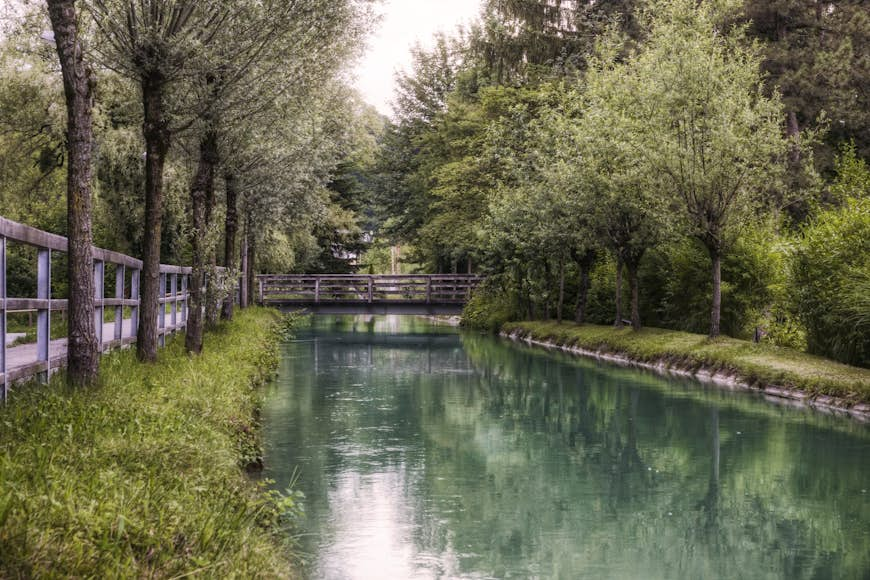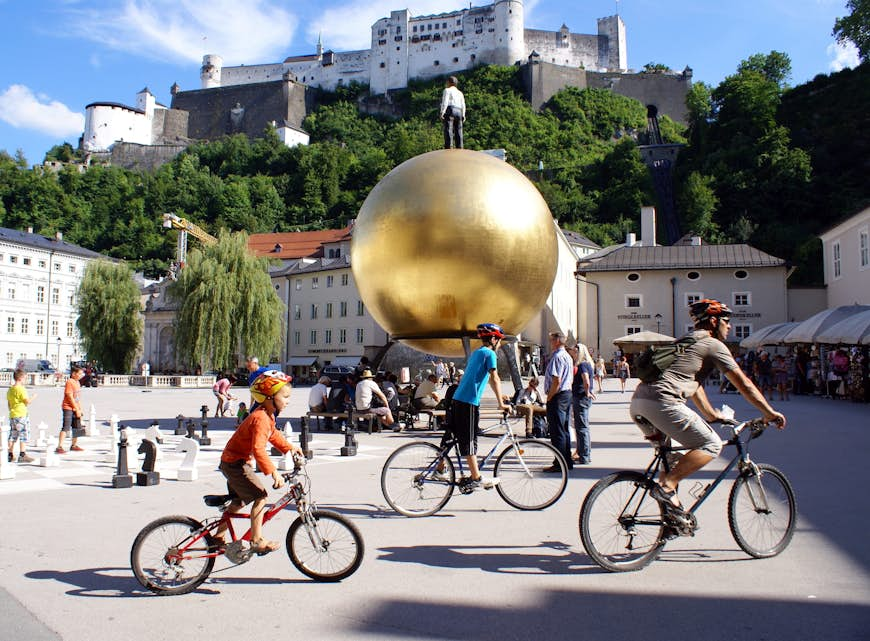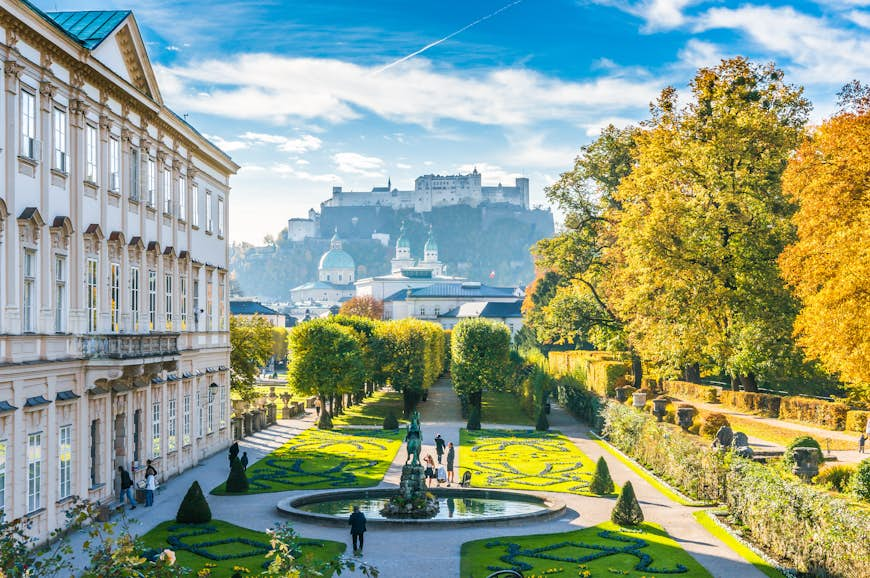Salzburg can feel terribly grand, with its parade of palaces and squares, where the prince-archbishops once wafted around and horse-drawn carriages clip-clop past evoking the glory days of the Hapsburg Empire. So it comes as a (very pleasant) surprise that you can see so much of the city without spending a single cent.
Mozart symphonies, skipping Marias (as in The Sound of Music), gorgeously manicured parks, public art, abbeys, cathedral concerts, jazz jam sessions and wild canal swims – time your visit right and you can tank up on culture and the outdoors in Salzburg for nothing. And, frankly, you’ll have a much better time than if you’d stuck to the usual tick-and-click tourist trail. Here’s our guide to seeing the city for free.
Get your Mozart and Maria fix
You can’t move for Mozart and Maria in Salzburg. And while it’s tempting to take an official tour of the composer’s hood and The Sound of Music film locations, you can see plenty without spending a single cent.
Piece together your own self-guided walking tour – GPSMYCITY has a free Mozart Walking Tour to get you started, which covers biggies like Mozartplatz, Residenz, where he gave his first court concert at the tender age of six, and the Dom where he was baptized in 1756.
If The Sound of Music is more your style (and, let’s face it, who doesn’t love a good mountain and yodeling nun), you can easily devise your own tour of the film locations. Top of your list should be stops like Benedictine convent Stift Nonnberg, where the nuns waltzed on their way to mass, Residenzplatz where a fountain-splashing Maria belts out “I Have Confidence” and the fortress-facing Mirabell gardens where she teaches the kids to sing “Do-Re-Mi”.
Spend time outdoors
With uplifting views of the Alps and a shockingly turquoise river running right through it, Salzburg is just as much about the outdoors as the urban. Its gardens are fabulous and free, from the sculpture-dotted parterres, rose gardens and leafy arbors of Schloss Mirabell (incidentally the best vantage point for photos of the fortress-topped Altstadt) to the Volksgarten, with its summer lido and beach.
Rent a bike and you can pedal gleefully along the riverbanks, mountains looming on horizon, on the 4.5km route to Schloss Hellbrunn, where it’s free to romp around the sculpture-strewn palace gardens, and sing your heart out at The Sound of Music pavilion of “Sixteen Going on Seventeen” fame.
See the city from on high
Salzburg is at its most heart-stoppingly beautiful from above. One of the most memorable ways to see the city away from the tourist masses is to hike above its skyline of elegant rooftops, spires and domes. Puff up the Nonnbergstiege to Stift Nonnberg for an on-high walk to Festung Hohensalzburg, with dress-circle views of the Alstadt.
You can easily devote an afternoon to wandering the 540m peak of Mönchsberg, whose cliffs rise above the city like theater curtains. The mountain (locals used to bigger things call it a “hill”) is wooded and criss-crossed by walking trails. A highly scenic hike leads 4km from Stift Nonnberg to the historic monastery-founded brewery Augustiner Bräustübl, where you can rest up with a cold foamy one under the chestnut trees.
Over the river on the Right Bank is the forested, 640m-high hump of Kapuzinerberg, which frames the Altstadt like a postcard. Paths twist past Way of the Cross chapels to the Capuchin abbey at the top. Despite the glorious views, it’s rarely busy – hence the reason it is still home to a colony of nimble-footed chamois, which you might spot if you’re lucky (and quiet).

Go for a canal swim
Flowing through the city since the Middle Ages, with its network of hidden underground waterways, Salzburg’s Almkanal provides a splash of history. In summer, you can cycle or walk to Schloss Leopoldskron (the palatial backdrop for the lake scene in The Sound of Music) for a bracing swim in the canal’s chilly turquoise waters. If you happen to have a board handy, you can join surfers to ride the canal’s wave just north of Weidenstrasse bridge.
Swan around a palace
Schloss Mirabell is fantasy Salzburg in a regal nutshell. Prince-Archbishop Wolf Dietrich von Raitenau had the palace built in 1606 to woo his lovely mistress, Salome Alt, who went on to bear him 15 children. In the 18th century, Hapsburg “starchitect” Johann Lukas von Hildebrandt worked his baroque magic here and you can take a peek at his handiwork for free whenever the palace is open. The scene-stealer is the Marmorsaal (Marble Hall), a riotous feast of marble, carved and gilded stucco and weighty chandeliers.
The marble Engeltreppe (Angel Staircase) sweeping up to the hall is festooned with playful, plump-cheeked cherubs. Legend has it that you will be blessed with good fortune in your marriage if you slap one on the bottom…
Marvel at holy wonders
One glance at the spires and domes encrusting Salzburg’s skyline tells you that this is a place built high and mighty on faith. And one way to really feel the city’s spirit is by devising your own mini tour of its places of worship. Kick off at Salzburg’s cathedral, or Dom, the cherry on the Altstadt’s historic cake. It’s free to see this masterpiece of baroque art, with its immense copper dome, nave adorned with Arsenio Mascagni’s ceiling frescos recounting the Passion of Christ, and bronze font where Mozart and Silent Night lyricist Joseph Mohr were baptized.
Catch the cathedral at its most atmospheric by attending 10am Sunday mass, when the organ is cranked into action for a free concert of Mozart’s sacred music. The composer was once an organist here.
From here, it’s just a couple of minutes’ stroll to Stift St Peter – founded by a Frankish missionary called Rupert around 700 AD, this is the oldest abbey-church and monastery complex in the German-speaking world. It’s free to visit the church, which bombards you with baroque ornament, including eye-catching altarpieces by Martin Johann Schmidt. Among the cemetery’s filigree wrought-iron crosses, you’ll find the graves of Austrian classical composer Michael Haydn (1737–1806), opera singer Richard Mayr (1877–1935) and Salzburg confectioner Paul Fürst (1856–1941).
By far one of the most atmospheric free things you can do in Salzburg is to walk up the Nonnbergstiege to Stift Nonnberg as the rising sun lights up the city’s rooftops and the hair’s-on-end sound of nuns singing Gregorian chants drifts out of the 1300-year-old Benedictine convent.

Explore public art
Art is not just confined to museums in Salzburg. Bridging the gap between culture and the outdoors and shining a light on often overlooked areas of the city, there is a rich stash of public art dotted all over town, which won’t cost you a thing to admire.
The Walk of Modern Art should be high on your agenda, spotlighting specially commissioned installations and sculptures that have Salzburg’s cultural identity as a common thread. Here attention-grabbers include James Turrell’s exposed-to-the-elements Skyspace atop Mönchsberg, Stephan Balkenhol’s giant man-on-a-golden-globe Sphaera on Kapitelplatz, and Anselm Kiefer’s winged book stack The Language of Birds at Chiemseehof.
In the warmer months, roam the well-worn cobbles of Steingasse, the main trade route to Italy in the Middle Ages, to reach Schloss Arenberg. Built for the lordly prince-archbishops in the 14th century, the palace’s beautiful grounds conceal the Würth Sculpture Garden, brimming with contemporary, thought-provoking artworks.
Feel the festive groove
As a vivacious, music-loving, culture-mad city, Salzburg has a jam-packed calendar of events, some of which are free. In summer, brass bands reverberate through the Altstadt when Vielklang comes to town, and Kapitelplatz gets crowds into the swing of the Salzburg Festival showing opera for free on a big screen. Kapitelplatz is also the castle-crowned backdrop for free movie nights at Sternenkino, held over two weeks from late June to early July.
Mid October brings Jazz & The City, with jazz acts – from rising stars to big names – hitting venues all over the city, from baroque churches to beer halls. But if you can’t make it then, you can catch free jam sessions every Tuesday at Jazzit.
